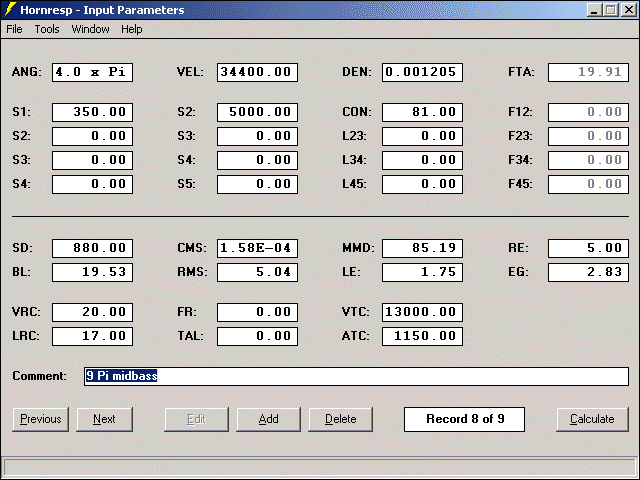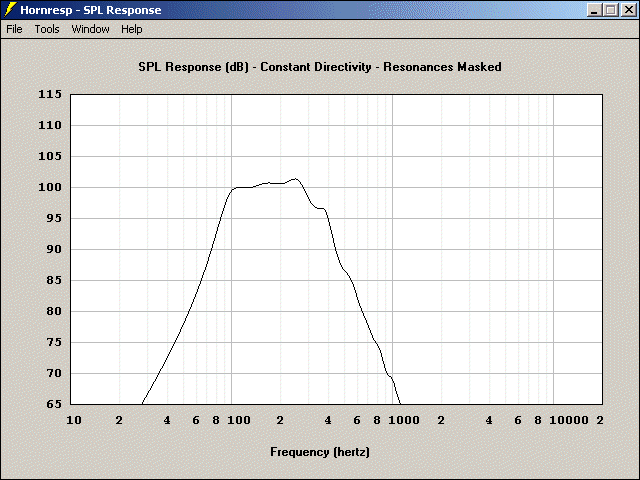| what design can i throw 8 jbl 2206J's in? [message #51314] |
Tue, 07 August 2007 10:58  |
 Vincent Molino
Vincent Molino
Messages: 9
Registered: May 2009
|
Esquire |
|
|
im gonna get the 12pi as soon as i sell my 2 srx728s's on ebay but i need a good mid bass folded horn....that puts out about 60-300 hertx. Which pi design can i put these in and can u give me a spl chart...thanks.
|
|
|
|
|
|
|
|
| Re: 9π midhorn, perhaps [message #51321 is a reply to message #51319] |
Wed, 08 August 2007 09:40   |
 |
 Wayne Parham
Wayne Parham
Messages: 18680
Registered: January 2001
|
Illuminati (33rd Degree) |
|
|
Yes, midhorns have to be fairly long. Their length should be at least 1/4λ of the cutoff frequency. The 9π midbass horn, for example, is 32" long. That will work down to about 100Hz. You can see from the Hornresp model, that's where it starts to roll off.

9 π Midbass Hornresp input screen

9 π Midbass SPL response
|
|
|
|
|
|
|
|
| Push-pull versus shorting rings [message #51325 is a reply to message #51324] |
Wed, 08 August 2007 10:08   |
 |
 Wayne Parham
Wayne Parham
Messages: 18680
Registered: January 2001
|
Illuminati (33rd Degree) |
|
|
I like the push-pull configuration too. But shorting rings work very well at midbass frequencies up. Push-pull works best as frequency drops, at least the version I'm talking about, which is a pneumatic/acoustic implementation where two drivers are mounted physically opposite and driven opposite in order to cancel mechanical asymmetry.
The reason for the shorting ring's "preference" to higher frequency is that it is an electro-magnetic device. Just like coils have to be large to work at low frequency, so do shorting rings, which are essentially single-turn coils.
Mechanical push-pull works best as frequency drops. This is because it is summing acoustically, in the air. So the drivers have to couple together, and this gets increasingly harder as frequency goes up. The drivers just aren't coupled together as well at higher frequencies because they grow further apart in phase. The lower the frequency, the closer in phase the two drivers are.
As to size, we're making a prototype 10π right now. But it isn't a midbass horn, it's a hornsub just like the 12π. It's smaller and easier to carry, which is attractive for smaller shows. The 12π is fine if you use a truck with a ramp, because it is designed to fit right on it. But if you have to carry them across a field, it's a drag. So the 10π is designed to address this.
The 10π basshorn subwoofer is half the size of the 12π, and is designed to be used in complementary pairs. It incorporates push-pull drive when used in compementary pairs as designed, but the trade-off is that it may not receive as much distortion reduction from push-pull drive as the 12π does because the drivers are further apart. Summing is done at the mouth, not the throat. I expect distortion reduction to be good at very low frequencies but that it becomes less effective as frequency rises. We'll be able to quantify this more definitely after measuring the prototype.
|
|
|
|
|
|
| Re: Push-pull versus shorting rings [message #51328 is a reply to message #51326] |
Wed, 08 August 2007 12:14   |
 |
 Wayne Parham
Wayne Parham
Messages: 18680
Registered: January 2001
|
Illuminati (33rd Degree) |
|
|
To understand how either push-pull drive or shorting rings work, you have to understand what they're trying to fix.
Basically, the problem is that the force that moves the cone is not perfectly linear, and its back and forth motion is not perfectly symmetrical. This is because the magnetic field generated by the voice coil deforms the magnetic field of the fixed magnet. This causes eddy currents in the magnetic circuit, literally modulating the flux. Further, the magnetic circuit is made of several parts, the center pole, top plate and back plate, in addition to the magnet itself. These may saturate at different levels, which will also cause force asymmetry. These are the primary causes of distortion in a loudspeaker.
Push-pull drive is pretty simple to implement, from an engineering perspective. All you have to do is take two identical motors and run them in opposite directions. Position them so that the drive force combines in an additive fashion, and voila! You have push-pull drive. Any asymmetries in an individual drive unit will cancel by using complementary pairs. Essentially you have a strong motor and a weak motor on each half cycle. On each contiguous half cycle, the strong one and the weak one flip.
This can be as simple as taking two identical loudspeakers and running one backwards on the baffle. You have to also reverse polarity on the reverse-mounted driver so their acoustic outputs are in phase. Best results are obtained when the drivers are matched.
You can also take two identical motors run in opposite directions and physically connect them to a common point on a diaphragm. This is another approach that does the same thing. In either case, the solution is essentially mechanical, using two drive units. Each one alternates between being slightly stronger and slightly weaker on each half cycle. The net force is equalized by having them work as a complementary pair.
Shorting rings work a different way. The idea with them is to correct the drive force, itself. To do this, a shorting ring is installed so that the electromagnetic field generated from the voice coil induces a current within the shorting ring. The current flowing through the shorting ring creates its own magnetic field. If the shorting ring is properly sized and placed, it will create a force that is equal and opposite to the difference. The idea is to counteract flux modulation, so that the force in both directions is the same.
A shorting ring is more difficult to do from an engineering perspective. It also requires more machining in the motor core. The size, position and conducting material of the ring contribute to the force it generates, and it must be made to precisely counteract the effects of flux modulation. This is not trivial, and different manufacturers have had varying degrees of success implementing shorting rings. In other words, not all speakers with shorting rings are equal.
|
|
|
|
| Re: 9π midhorn, perhaps [message #51354 is a reply to message #51318] |
Sun, 19 August 2007 18:30   |
 Vincent Molino
Vincent Molino
Messages: 9
Registered: May 2009
|
Esquire |
|
|
|
so Wayne...can i make the mouth's 1/4 the size since im putting 4 together on each side...for wieght i can make 2 - doule 12's that strap together.....or maybe a big quad box? im having the hardest time deciding what to biuld. Do i really need to enclose these in horns at all for small-mid size indoor venues? also if you stick a DR box in a corner....and a folded horn in a corner.....will thier be that muck of a differenced... thanks for your help so far.
|
|
|
|







